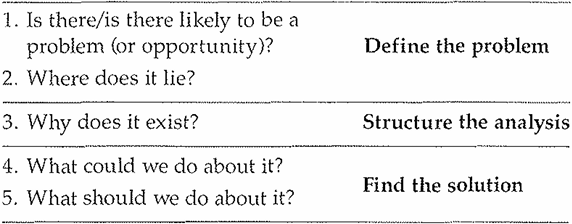
DEFINING THE PROBLEM
 المؤلف:
BARBARA MINTO
المؤلف:
BARBARA MINTO
 المصدر:
THE MINTO PYRAMID PRINCIPLE
المصدر:
THE MINTO PYRAMID PRINCIPLE
 الجزء والصفحة:
121-8
الجزء والصفحة:
121-8
 2024-09-16
2024-09-16
 707
707
DEFINING THE PROBLEM
When you decide that a problem exists, you are usually perceiving a gap between the results you get now from a certain line of endeavor and the results you would rather have had. You are essentially recognizing that a particular situation in the world yields a specific result, which I call the Undesired Result (Rl).

The problem is that you do not like the result (e.g., Sales are declining), and you want some other result (e.g., Sales to be growing), which I call the Desired Result (R2). The solution then tells you how to get from R1 to R2.
Defining a problem in this way begins the process of Sequential Analysis,1 a particularly efficient problem-solving technique that involves finding the answers to a series of questions in logical sequence:
1. Is there/is there likely to be a problem (or opportunity)?
2. Where does it lie?
3. Why does it exist
4. What could we do about it?
5. What should we do about it?
1 Holland. B. Robert, Sequential Analysis, McKinsey & Company, London, 1972
The answers to the first two questions serve to define the problem, question 3 points you to finding its causes, and questions 4 and 5 deal with determining the best way to eliminate the problem (or to take advantage of the opportunity):

In communicating the results of your analysis, the answers to questions 1 and 2 become the introduction to your document, while the answers to the other questions lead to the points in the pyramid. I will present a formal way to define the problem so that you can move easily from it to write the introduction to a proposal or a final report.
 الاكثر قراءة في Writing
الاكثر قراءة في Writing
 اخر الاخبار
اخر الاخبار
اخبار العتبة العباسية المقدسة


